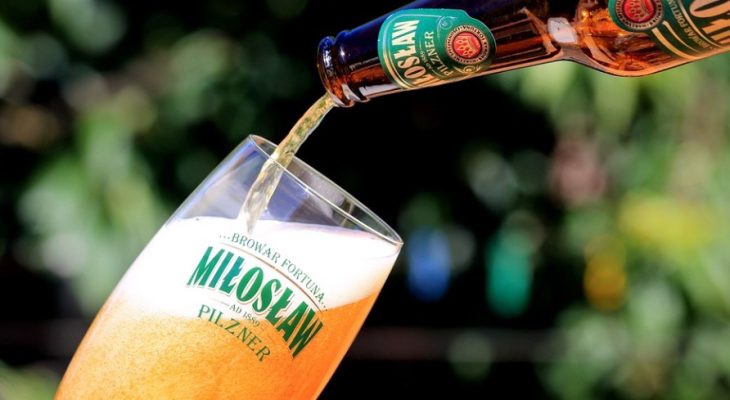The Proper Beer Serving Temperatures (and Why)

Beer provides a unique taste and experience, coming in a wide range of types, flavors, and alcohol by volume (ABV). You can make the drinking experience better by serving the beer at the right temperature.
A beer’s average serving temperature is 38-55 °F (3.33-12.78 °C). Light and weak beers are best served at 33-45 °F (0.56-7.22 °C), dark beers at 45-50 °F (7.22-10 °C), and strong beers are served warmer at 45-55 °F (7.22-12.78 °C). Serving beer at the proper temperature affects its flavor and aroma.
Different beers have different optimal serving temperatures. Read on to know the best serving temperatures, why they are essential, and how to maintain them to enjoy your beer’s full potential.
Beer Serving Temperatures Explained
The ideal serving temperature for all beers is between 38 – 55 °F (3.33 – 12.78 °C), which is significant because the yeast will ferment the sugars in the beer and produce carbon dioxide as a byproduct at this temperature.
If beer sits too long at warm temperatures, the yeast will have time to multiply and consume excessive amounts of alcohol. The longer beer sits at warm temperatures, the more intense and bitter it will become.
When serving beer cold, there are two things you must consider if you want your beer to taste great:
- Cold temperatures slow down the fermentation process, so it takes longer for the yeast to work on the sugars in your beer.
- Cold temperatures slow the yeast’s reproduction rate, so only a certain number of yeast cells can reproduce at any given time. Therefore, you’ll get fewer off-flavors than you would with warm-temperature beers.
For these reasons, rigid-serving temperatures are preferable for most beers.
Why Serve Beer at Optimum Temperature?
Keeping your beer at the right temperature is essential to serving it at its optimum flavor and aroma potential because temperature affects the flavors and aromas of the beer.
The Beer’s Flavor Decreases If You Serve It Too Warm
A warm beer brings out more of its quintessential flavor. Still, as it gets closer to room temperature, the carbonation and acidity of the hops fade, resulting in a bland taste. Serving beer at too warm a temperature can make it go flat or sour, which is a result of the way yeast works.
When you serve beer at warmer temperatures, the yeast starts to interact with the sugar, displacing any liquid left behind, resulting in flat beers and a musty flavor from old yeast.
Bacteria growth is another problem when beer is served too warm. When the beer’s temperature rises above 60°F (15.56°C), it becomes more hospitable for bacteria to grow because it’s not killed off as quickly by the heat.
The Beer Loses Its True Essense If You Serve It Too Cold
An ice-cold beer is nice, but if you serve it too cold, the aromatic components don’t volatilize, leaving it tasteless and thin.
While an ice-cold beer is an essential factor in the enjoyment of beer, when served too cold or ice-cold, it can be hard to drink and not taste as good. An almost frozen or thawed beer can increase the alcohol content, which means you’ll end up worse for wear without realizing why.
Temperature Guidelines for Serving Beer
Serving beer at the correct temperature will make an enormous difference in its taste, smell, and aftertaste. However, there is no one right answer for every brew.
Here are the optimal serving temperatures of different beer types:
- All beers should be served at 38 – 55°F (3.33 – 12.78°C).
- Light and weak beers are best served the coldest at 33 – 45 °F (0.56 – 7.22°C).
- Dark beers are served warmer than light and weak beers at 45 – 50 °F (7.22 – 10°C).
- Strong beers are served warmer than other types at 45 – 55°F (7.22 – 12.78°C).
The chart below will give you some valuable pointers on serving many different types of beer based on their optimum storage temperatures.
| BEER | TEMPERATURE |
| Malt liquor Bottom-shelf beers Mainstream light lagers | 33 – 45°F (0.56 – 7.22°C) |
| Craft lagers Munich Helles Pilsners Kölsch ales Wheat beers (Berliner Weisse, Hefeweizen, and Witbier) | 38 – 45°F (3.33 – 7.22°C) |
| Abbey Tripels Blonde and cream ales Belgian pale ales Nitro stouts | 40 – 45°F (4.44 – 7.22°C) |
| IPAs Pale ales Porters Most stouts Dark lagers | 45 – 50°F (7.22 – 10°C) |
| Belgian ales (Saisons and sour beer) Baltic porter German bock Bitter (English) Mild (English) Ales (Scottish) Maibock lagers | 50 – 55°F (10 – 12.78°C) |
| Belgian strong ales Barleywines Mead Imperial stouts Doppelbocks | 55 – 60°F (13 – 16°C) |
Check out this video explaining all the different beer types, and see if you can guess their best-serving temperature:
Tips for Maintaining Beer Temperature
It can be confusing to remember how beer should be served and what temperature it should be kept, but here are some tips on how to maintain beer temperature.
- Proper beer storage is the most crucial factor, as extreme temperatures can cause a drop in carbonation and flavor.
- Make sure that your fermentation chamber or keg is not exposed to direct sunlight, which can lead to temperature fluctuations.
- Beer should be served a bit colder than the ideal temperature because the drink will warm up slightly once you serve it due to factors like, for example, the drinker’s hands.
- Keep your beer cold using a kegerator or other home draft system, which can be highly efficient at maintaining its coldness. They also make pouring a lot easier than you would with traditional bottles.
Final Thoughts
There are many different beer types, each with its own set of optimal serving temperatures. While it can be daunting to maintain a temperature system for your entire cellar or house, it can be done.
And when done correctly, you can keep your beer tasting its best while reducing the chances of bacterial growth. All beers should be served between 38 – 55°F (3.33 – 12.78°C). If the temperature is too low, the beer won’t ferment properly. Serve it too warm, and the flavor will be muted.






